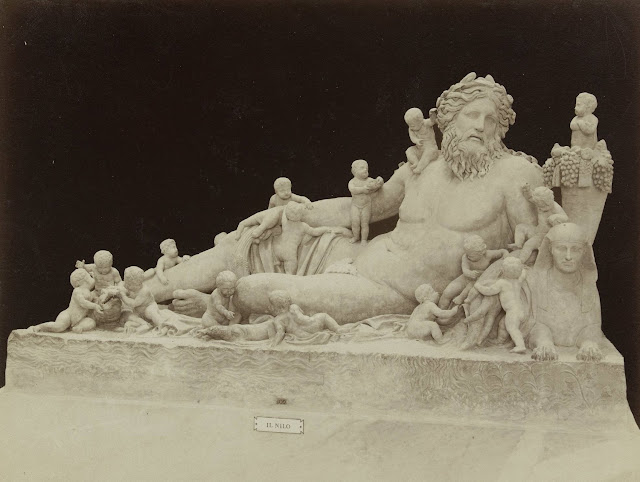 |
| Roman Empire Statue of a River God, known as Marforio 2nd-3rd century AD marble Musei Capitolini, Rome |
"To Cavallini in the fourteenth century the statue [above] was the son of Mars ('filii Martis') which had been corrupted to Marfoli, but by the early fifteenth century its vulgar name was apparently Marforio. It was then that Flavio Biondo proposed that the statue had in fact nothing to do with Mars but represented Jove Panario (or of the Bakers), to whom an altar had been erected on the Capitol. He supposed the lumpy rocks by which the figure reclines to be the loaves which the Romans defending the Capitol pelted upon the besieging Gauls (hence deceiving them into supposing that they had an inexhaustible bread supply). This interpretation was challenged by Fulvio who, in 1527, proposed that the popular name Marforio was a corruption of Nar Fluvius, Nar being the Roman name for the river Nera, a tributary of the Tiber. This idea was prompted by Fulvio's recognition that the statue must be a river god – a class of antique statue unknown in the quattrocento."
– Francis Haskell and Nicholas Penny, Taste and the Antique (Yale University Press, 1981)
 |
| Anonymous Italian Artist Antique Statues known as Marforio and Pasquino 1547 etching Philadelphia Museum of Art |
 |
| Antoine Lafréry (publisher) Antique Statue of a River God, known as Marforio 1550 engraving British Museum |
 |
| Polidoro da Caravaggio River God before 1543 oil on canvas Museum of Fine Arts, Boston |
 |
| Giovanni Battista Scultori River God 1538 engraving Scottish National Gallery, Edinburgh |
 |
| Anonymous Italian Artist River God 17th century oil on canvas Temple Newsam House, Leeds, Yorkshire |
 |
| Carle Vanloo River God before 1765 oil on canvas Nationalmuseum, Stockholm |
The River God
I may be smelly, and I may be old,
Rough in my pebbles, reedy in my pools,
But where my fish float by I bless their swimming
And I like the people to bathe in me, especially women.
But I can drown the fools
Who bathe too close to the weir, contrary to rules.
And they take a long time drowning
As I throw them up now and then in a spirit of clowning.
Hi yih, yippity-yap, merrily I flow,
O I may be an old foul river but I have plenty of go.
Once there was a lady who was too bold
She bathed in me by the tall black cliff where the water runs cold,
So I brought her down here
To be my beautiful dear.
Oh will she stay with me will she stay
This beautiful lady, or will she go away?
She lies in my beautiful deep river bed with many a weed
To hold her, and many a waving reed.
Oh who would guess what a beautiful white face lies there
Waiting for me to smooth and wash away the fear
She looks at me with. Hi yih, do not let her
Go. There is no one on earth who does not forget her
Now. They say I am a foolish old smelly river
But they do not know of my wide original bed
Where the lady waits, with her golden sleepy head.
If she wishes to go I will not forgive her.
– Stevie Smith (ca. 1950)
 |
| Anonymous Italian Artist Replica of Antique River God (Tiber) at the Louvre, since seizure in Rome by Napoleon ca. 1675-1700 terracotta statuette Hermitage, Saint Petersburg |
 |
| Charles Nègre Antique River God (Tiber) at the Louvre (displayed in the Jardin des Tuileries) 1859 albumen silver print Philadelphia Museum of Art |
 |
| Jean-Nicolas Langier Antique River God (Tiber) at the Louvre, after seizure in Rome by Napoleon 1816-18 etching and engraving Philadelphia Museum of Art |
 |
| Claude Randon Antique River God (Tiber) in Rome, before seizure by Napoleon ca. 1704 engraving Philadelphia Museum of Art |
 |
| Benedetto Pistrucci Head of Antique River God (Nile) at the Vatican ca. 1838 onyx cameo Kunsthistorisches Museum, Vienna |
 |
| Giovanni Volpato Replica of Antique River God (Nile) at the Vatican ca. 1785-96 porcelain Metropolitan Museum of Art, New York |
 |
| James Anderson Antique River God (Nile) at the Vatican ca. 1845-55 albumen silver print Getty Museum, Los Angeles |
 |
| Anonymous Photographer Antique River God (Nile) at the Vatican ca. 1880-1904 photograph Rijksmuseum, Amsterdam |